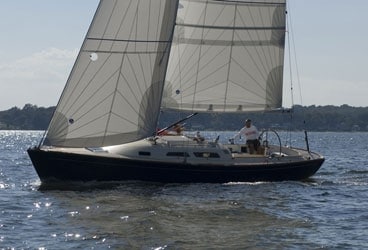
SabreSpiritReview368
When it came to producing their version of the recently popular class of boats known as daysailers, Sabre took the long view, waiting a few years to see who came up with what good ideas, and what seemed to be popular before they introduced their Sabre Spirit into the fray. There other wise move was to retain designer Jim Taylor for the design work. The result is a sharp-looking, well-performing daysailer that not only works as a weekender, but a racer as well. With a self-tailing electric main halyard winch and roller-furling, self-tacking jib, it was a snap to get sailing. Upwind, the GPS showed us sailing at 5.6 knots in 6 to 7 knots of wind, and when the breeze lightened we sailed faster than wind speed. Sail controls are designed and led for both shorthanded and crewed sailing. The mainsheet is led to winches on each side of the cockpit, within reach of the helm but also far enough away to allow a main trimmer room when sailing fully crewed. The wheel has a light touch, but still offers enough feedback to assist trimming for proper upwind weather helm.Downwind, setting the kite is also simple; pull the halyard to the masthead, tack line to the bow, raise the snuffer, and sheet in. Without a sprit this asymmetric is narrower than most, but still flew well in our light-air, flat-water test conditions. It also jibed with ease.The fractional rig has enough sail area to move the boat along in light air yet looks as if it would be easy to set up for breezy conditions. The Sabre Spirit uses a Selden/Furlex roller-furling headfoil designed to keep the furling drum below deck and minimize forestay sag. A self-contained hydraulic ram adjusts the topmast backstay of the fractional Hall carbon mast, simultaneously controlling mast bend and forestay tension. Rod shrouds lead over two sets of aft swept spreaders. This combination of carbon mast, continuous rod rigging, and aluminum boom is a cost-effective way of obtaining great performance. The deck arrangement worked well, ergonomically, in many ways. The cockpit coamings are long, protecting the crew from any water that may accumulate on the weather deck. Their angles and curves were conducive to sitting outboard, which offers a better view of the sails and waves. Many daysailers have comfortable cockpits, but few have equally comfortable interiors. The Spirit has both, and belowdecks there are two central settees, great for lounging or entertaining. The navigation table and electrical panel are at the forward end of the port settee, dividing this area from the forward V-berth. The galley is aft to port and the enclosed head is just to starboard of the companionway, not the usual location, but sensible for a daysailer. Sabre builds the Spirit with a fiberglass PVC foam core laminate, which gives strength and stiffness. Vinylester resin is used in the outside layers for blister resistance and polyester resin for the balance of the laminate. Additional transverse floor beams stiffen the keel area where stainless steel keel bolts and silicon bronze nuts can be inspected under the cabin sole. Shroud chainplates attach to composite knees that are cosmetically covered with cherry wood veneer. Sabre has put together a polished product that sails well and is easy to handle, both shorthanded and fully crewed. The boat is simple enough to rig that even a two-hour window in a busy schedule should be plenty of time for sailing. With a PHRF New England rating of 87, a Sabre Spirit won Marblehead’s PHRF Boat of the Year. Equipped as we sailed the boat at $300,000 the Sabre Spirit is a winning combination of speedy daysailer with true weekend cruising and racing capabilities.
For SW‘s complete 2008 Boat of the Year coverage, click here









